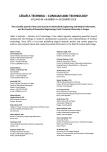THE EFFECT OF SPEED ON GAIT ASYMMETRY IN SUBJECT WITH CONGENITAL TIBIAL DEFICIENCY: A CASE STUDY
Authors:
Jitka Marencakova; Tomas Gryc; Frantisek Zahalka
Authors‘ workplace:
Sport research centre, Faculty of Physical Education and Sport, Charles University, Prague, Czech Republic
Published in:
Lékař a technika - Clinician and Technology No. 4, 2019, 49, 112-118
Category:
Overview
Congenital tibial deficiency is a rare developmental skeletal disorder. When the surgical treatment fails the amputation and/or prosthesis is needed. Recent studies of prosthetic gait present only data for acquired case of prosthetic gait, mainly measured in comfortable self-selected speed, which does not reflect changes visible only during higher demands conditions i.e. faster gait. Prosthetic gait of acquired cases (i.e. traumatic amputation) differs from normal gait mostly in gait asymmetry (GA). However, it was not yet studied in a developmental case of prosthetic gait. In this case study, GA changes in different speed of walking with ankle-foot prosthesis were identified for unilateral congenital tibial deficiency in a young healthy man. Selected joint kinematic, spatial-temporal, and kinetic gait parameters were collected using 3D motion capture system and treadmill with force plate simultaneously. Mean values, SD, and symmetry indexes were calculated in different walking speeds and descriptively analyzed. Results show developmental prosthetic gait specific pattern and GA in most of the measured gait parameters. Kinematic parameters of joint angular ranges register decreasing GA with increasing gait speed on intact limb side. Spatial-temporal parameters present decreasing GA with increasing speed on the prosthetic limb side for double support and step duration. Kinetic parameters show increasing GA on intact limb in all parameters, except loading rate which decrease with increasing speed. In the case of congenital tibial deficiency, gait pattern, GA and compensatory mechanisms differ to the acquired prosthetic gait and depend on walking speed. These findings complete the missing point in prosthetic gait research and may serve as a base for further research of differences between developmental and acquired cases of prosthetic gait patterns.
Keywords:
Velocity – Walking – gait – symmetry index – prosthetic – congenital dysplasia of tibia – congenital tibial hemimelia – foot prosthesis – kinematic – kinetic – treadmill
Sources
- Fernandez-Palazzi F, Bendahan J, Rivas S. Congenital deficien-cy of the tibia: A report on 22 cases. J Pediatr Orthop Part B. 1998;7(4):298–302. DOI: 10.1097/01202412-199810000-00008
- Tokmakova K, Riddle EC, Kumar SJ. Type IV congenital defi-ciency of the tibia. J Pediatr Orthop. 2003;23(5):649–53.
- Kalamchi A, Dawe RV. Congenital deficiency of the tibia. J Bone Joint Surg Br. 1985;67(4):581–4.
- Litrenta J, Young M, Birch JG, Oetgen ME. Congenital Tibial Deficiency. J Am Acad Orthop Surg. 2019;27:268–79. DOI: 10.5435/JAAOS-D-16-00838
- Richards J. The comprehensive textbook of clincal biome-chanics. 2nd ed. Elsevier Health Sciences; 2018. 1–363 p.
- Torburn L, Perry J, Ayyappa E, Shanfield SL. Below-knee amputee gait with dynamic elastic response prosthetic feet: A pilot study. J Rehabil Res Dev. 1990;27(4):369–84.
- Gitter A, Czerniecki JM, DeGroot DM. Biomechanical analysis of the influence of prosthetic feet on below-knee amputee walking. Am J Phys Med Rehabil. 1991;70(3):142–8. DOI: 10.1097/00002060-199106000-00006
- Barth DG, Schumacher L, Thomas SS. Gait analysis and energy cost of below knee amputeewearing six different prosthetic feet. J Prosthetics Orthot. 1992;4(2):63–75.
- Gage JR, Hicks R. Gait analysis in prosthetics. Clin Prosthetics Orthot. 1985;9:17–23.
- Rietmann JS, Postema K, Geertzen JHB. Gait analysis in prosthetics: opinions, ideas and conclusions. Prosthet Orthot Int. 2002;26:50–7. DOI: 10.1080/03093640208726621
- Isakov E, Keren O, Benjuya N. Trans-tibial amputee gait: Time-distance parameters and EMG activity. Prosthet Orthot Int. 2000;24(3):216–20. DOI: 10.1080/03093640008726550
- Bohannon RW. Comfortable and maximum walking speed of adults aged 20-79 years: reference values and determinants. Age and Ageing. 1997;26:15–19. DOI: 10.1093/ageing/26.1.15
- Dingwell JB, Davis BL, Frazder DM. Use of an instrumented treadmill for real-time gait symmetry evaluation and feedback in normal and trans-tibial amputee subjects. Prosthet Orthot Int. 1996;20(2):101–10. DOI: 10.3109/03093649609164426
- Macfarlane PA, Nielsen DH, Shurr DG, Meier K. Perception of walking difficulty by below-knee amputees using a conventional foot versus the flex-foot. J Prosthetics Orthot. 1991;3(3):114–9.
- Jia X, Wang R, Zhang M, Li X. Influence of prosthetic sagittal alignment on trans-tibial amputee gait and compensating pattern: a case study. Tsinghua Sci Technol. 2008;13(5):581–6. DOI: 10.1016/S1007-0214(08)70095-6
- Sadeghi H, Allard P, Prince F, Labelle H. Symmetry and limb dominance in able-bodied gait: A review. Gait Posture. 2000;12(1):34–45. DOI: 10.1016/S0966-6362(00)00070-9
- Robinson RO, Herzog W, Nigg BM. Use of force platform variables to quantify the effects of chiropractic manipulation on gait symmetry. J Manipulative Physiol Ther [Internet]. 1987 Aug [cited 2019 Mar 26];10(4):172–6. Available from: http://www.ncbi.nlm.nih.gov/pubmed/2958572
- Herzog W, Nigg BM, Read L, Ollson E. Asymmetries in ground reaction force patterns in normal human gait. Med Sci Sport Exerc. 1989;21(1):110–4.
- Bell AL, Pedersen DR, Brand RA. A comparison of the accuracy of several hip center location prediction methods. J Biomech [Internet]. 1990;23(6):617–21.
DOI: 10.1016/0021-9290(90)90054-7 - Leardini A, Cappozzo A, Catani F, Toksvig-Larsen S, Petitto A, Sforza V, et al. Validation of a functional method for the estimation of hip joint centre location. J Biomech. 1999;32:99–103. DOI: 10.1016/S0021-9290(98)00148-1
- Cappozzo A, Catani F, Della Croce U, Leardini A. Position and orientation in space of bones during movement: anatomical frame definition and determination. Clin Biomech. 1995;10(4): 171–8. DOI: 10.1016/0268-0033(95)91394-T
- Rao SS, Boyd LA, Mulroy SJ, Bontrager EL, Gronley JK, Perry J. Segment velocities in normal and transtibial amputees: Pros-thetic design implications. IEEE Trans Rehabil Eng. 1998;6(2): 219–26. DOI: 10.1109/86.681188
- Zelik KE, Adamczyk PG. A unified perspective on ankle push-off in human walking. J Exp Biol. 2016;219(23):3676–83. DOI: 10.1242/jeb.140376
Labels
BiomedicineArticle was published in
The Clinician and Technology Journal

2019 Issue 4
Most read in this issue
- METHODS FOR KINEMATIC ANALYSIS OF HUMAN MOVEMENT IN MILITARY APPLICATIONS: A REVIEW OF CURRENT AND PROSPECTIVE METHODS
- THE EFFECT OF FRAME RATE AND CALIBRATION ON LUNG MONITORING WITH ELECTRICAL IMPEDANCE TOMOGRAPHY
- THE EFFECT OF SPEED ON GAIT ASYMMETRY IN SUBJECT WITH CONGENITAL TIBIAL DEFICIENCY: A CASE STUDY
- THE ADOPTION OF AUTOMATED FiO2 CONTROL INTO POLISH NICUS: 2012–2019
